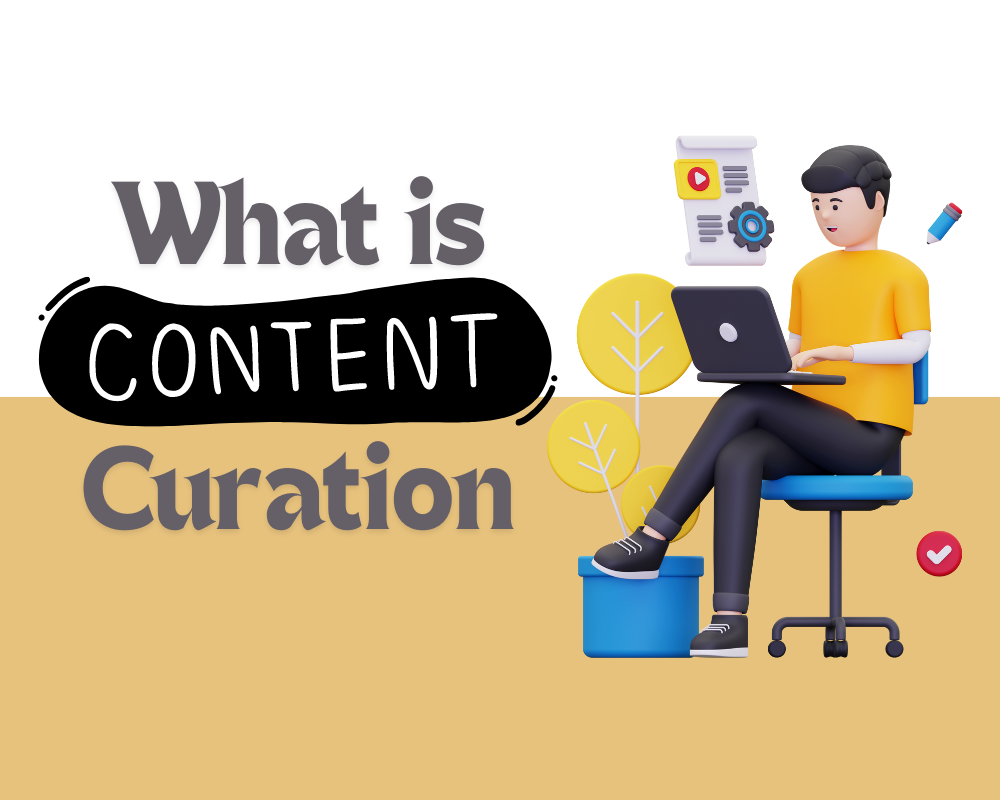Tired of your content getting lost in the noise? You’re not alone. Every day, countless articles, videos, and social media posts flood the internet, making it a challenge for any one piece of content to stand out. If you’re a content marketer, digital strategist, or small business owner, you’ve likely faced this problem head-on. You’ve put in the hard work to create valuable content, but how do you ensure it actually reaches the right audience?
Here’s the secret: It’s not just about creating great content; it’s about smart distribution. In this post, we’ll explore powerful content distribution hacks that will ensure your hard work gets the attention it deserves. From leveraging social media to repurposing content in new formats, these strategies will help you reach a wider audience and maximize your impact
Section 1: Understanding Content Distribution
When it comes to content marketing, creating high-quality content is only half the battle. The other half? Getting it in front of the right people. Content distribution is all about strategically sharing your content across various platforms to maximize visibility and engagement. It’s the process that turns your content from a hidden gem into a widely shared and discussed piece.
Think of content distribution as the bridge between your content and your audience. Without it, even the best articles or videos might go unnoticed. A well-crafted distribution strategy ensures that your content reaches its intended audience, whether they’re scrolling through their social media feed, reading emails, or browsing their favorite websites.
But why does content distribution matter so much? For one, it expands your reach far beyond your immediate audience. It helps build brand awareness, drives traffic to your site, and ultimately, contributes to your goals—be it generating leads, fostering engagement, or boosting sales. In short, effective content distribution is crucial for any marketer looking to maximize the impact of their content.
Now that we’ve covered the basics, let’s move on to the different channels you can use to distribute your content.
Section 2: Top Content Distribution Channels
When it comes to getting your content in front of the right people, choosing the right distribution channels is key. Not all platforms are created equal, and each one offers unique opportunities to engage with different segments of your audience. Let’s break down some of the top content distribution channels and explore the pros and cons of each.

1. Social Media
Social media platforms like Facebook, Twitter, LinkedIn, Instagram, and TikTok are some of the most popular channels for content distribution—and for good reason. They allow you to reach a wide audience quickly and foster direct engagement through likes, shares, and comments.
Pros:
- Wide Reach: Social media platforms have billions of active users, offering a vast audience pool.
- Engagement: These platforms facilitate two-way communication, helping you build relationships with your audience.
- Targeting: Advanced targeting options let you reach specific demographics, interests, and behaviors.
Cons:
- Algorithm Changes: Frequent changes to algorithms can affect your content’s visibility.
- Time-Consuming: Managing multiple social media accounts and creating platform-specific content can be labor-intensive.
2. Email
Email marketing remains one of the most effective ways to distribute content. With an engaged subscriber list, you can share your latest blog posts, videos, or podcasts directly with people who are already interested in your brand.
Pros:
- Direct Access: Emails land directly in the inbox of your subscribers, making it a very personal form of communication.
- High ROI: Email marketing often boasts a high return on investment due to its low cost and high conversion rates.
- Segmentation: You can segment your audience based on behavior, demographics, or past interactions, allowing for highly personalized content.
Cons:
- Deliverability Issues: Not all emails make it to the inbox; some might end up in spam folders.
- Requires Maintenance: Building and maintaining a clean, engaged email list takes time and effort.
3. Paid Advertising
Paid advertising, such as Google Ads or social media ads, can boost content visibility quickly. It’s particularly useful for promoting new content, events, or time-sensitive offers.
Pros:
- Immediate Results: Ads can drive traffic and engagement almost instantly.
- Precise Targeting: Ads can be finely targeted based on location, demographics, interests, and behaviors.
- Scalability: Paid campaigns can be scaled up or down depending on budget and goals.
Cons:
- Cost: Paid ads can be expensive, especially in competitive niches.
- Ad Fatigue: Audiences can become overwhelmed or annoyed by constant advertising, potentially leading to diminished returns.
4. Blogs and Websites
Publishing content on your own blog or website gives you complete control over the presentation and user experience. It also provides an opportunity to optimize for SEO, helping your content appear in search engine results.
Pros:
- Ownership: You own the platform, so you control the user experience, design, and data.
- SEO Benefits: Optimizing your content for search engines can drive organic traffic to your site over the long term.
- Long-Form Content: Blogs allow for in-depth exploration of topics, which can establish your brand as an authority.
Cons:
- Traffic Dependence: The success of your content depends on your site’s traffic. Without a strong audience base, it may go unnoticed.
- Time-Intensive: Creating high-quality, SEO-optimized content requires significant time and effort.
Each of these channels offers unique advantages and challenges, so it’s important to choose the ones that align best with your audience and goals. Most successful content distribution strategies involve a mix of these channels to maximize reach and engagement.
Section 3: Hacks for Social Media Distribution
Social media is a powerhouse for content distribution, but with millions of posts published every day, it’s easy for your content to get lost in the shuffle. To ensure your content stands out, you need to optimize your approach for each platform and take advantage of smart distribution tactics. Here are some hacks to help you maximize your social media reach.
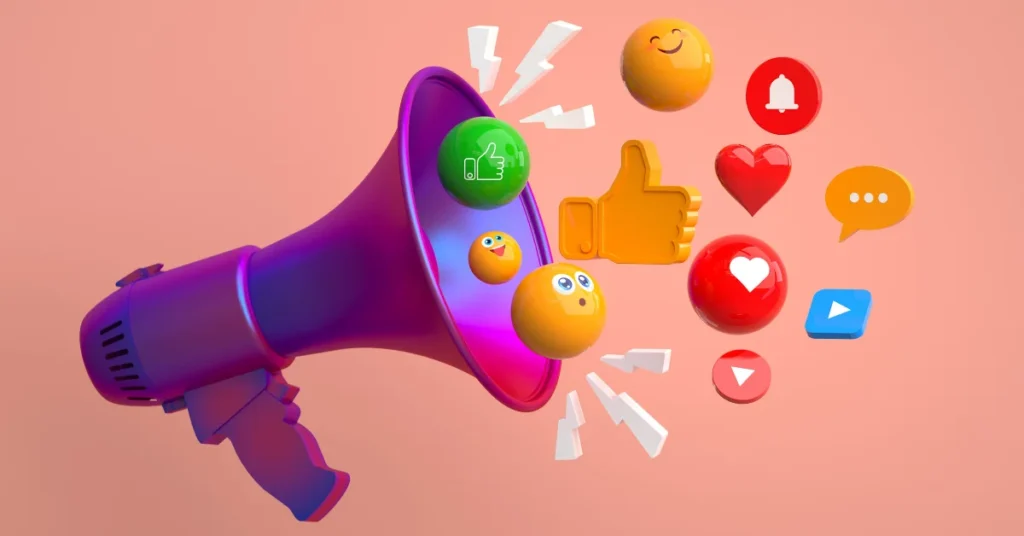
1. Optimize Content for Each Platform
Each social media platform has its own unique audience and preferred content style. What works on Instagram might not be as effective on LinkedIn. To get the best results, tailor your content to fit each platform:
- Facebook: Focus on engaging visuals and videos. Write concise, compelling captions and use Facebook’s native tools like Stories and Live videos to boost engagement.
- Twitter: Keep it brief and punchy. Twitter’s character limit means you need to make every word count. Use trending hashtags to increase visibility and join relevant conversations.
- LinkedIn: This is the place for professional, in-depth content. Share industry insights, thought leadership articles, and company news. Posts with images, videos, or documents (like PDFs) perform better than text-only posts.
- Instagram: Visual appeal is everything. High-quality images and videos, along with engaging Stories and Reels, can help capture attention. Use relevant hashtags and location tags to increase discoverability.
- TikTok: Short, engaging videos are key here. Trend-based content, challenges, and behind-the-scenes glimpses can drive engagement. Be authentic and capitalize on trending sounds and hashtags.
2. Schedule Posts at Optimal Times
Timing can significantly impact your content’s visibility and engagement. Different platforms have peak times when users are most active. Use social media analytics or tools like Buffer or Hootsuite to determine when your audience is online and schedule your posts accordingly. While the best times can vary by platform and audience, here are some general guidelines:
- Facebook and Instagram: Early mornings and evenings, particularly on weekdays.
- Twitter: Lunchtime (around 12 p.m.) and late afternoons on weekdays.
- LinkedIn: Mornings, particularly midweek (Tuesday to Thursday).
- TikTok: Evenings and weekends, when users have more free time to browse.
3. Utilize Social Media Analytics
Analytics are your best friend when it comes to refining your social media strategy. Most platforms offer built-in analytics tools that can provide insights into how your content is performing. Pay attention to metrics like reach, engagement, and click-through rates to identify what’s working and what’s not. Use this data to:
- Identify Top-Performing Content: Replicate or repurpose content that has previously performed well.
- Understand Audience Preferences: Learn which types of content your audience engages with most.
- Adjust Posting Times and Frequency: Find the sweet spot for how often and when you should post to maximize engagement.
4. Engage with Your Audience
Social media isn’t just a distribution channel; it’s also a platform for building relationships. Engaging with your audience by responding to comments, participating in conversations, and sharing user-generated content can help foster a sense of community and loyalty. Some engagement strategies include:
- Ask Questions: Encourage interaction by asking your audience for their opinions or experiences related to your content.
- Run Contests and Giveaways: These can drive engagement and increase your content’s reach as users share it with their networks.
- Share User-Generated Content: Highlighting content created by your followers not only strengthens community bonds but also expands your reach as those followers share your posts.
5. Use Paid Promotions Sparingly
While organic reach is ideal, sometimes a small boost is necessary. Paid promotions can help amplify your best content, especially if it’s not getting the attention it deserves. When using paid promotions:
- Promote Top-Performing Content: Boost posts that have already proven to be popular to get even more mileage out of them.
- Target Specific Audiences: Use the targeting options available on platforms like Facebook and Instagram to reach a specific demographic or interest group.
- Set a Budget and Monitor Performance: Start with a small budget, track the performance, and adjust as needed to optimize your ad spend.
By implementing these social media hacks, you can significantly increase the reach and impact of your content. Next, let’s explore how email marketing can be a powerful tool for content distribution.
Section 4: Email Marketing for Content Promotion
Email marketing is one of the most effective tools for content distribution. It offers a direct line to your audience, allowing you to share your content with people who have already expressed interest in your brand. When done right, email marketing can drive significant traffic to your content and foster deeper engagement with your audience. Here’s how to leverage email marketing for maximum impact.
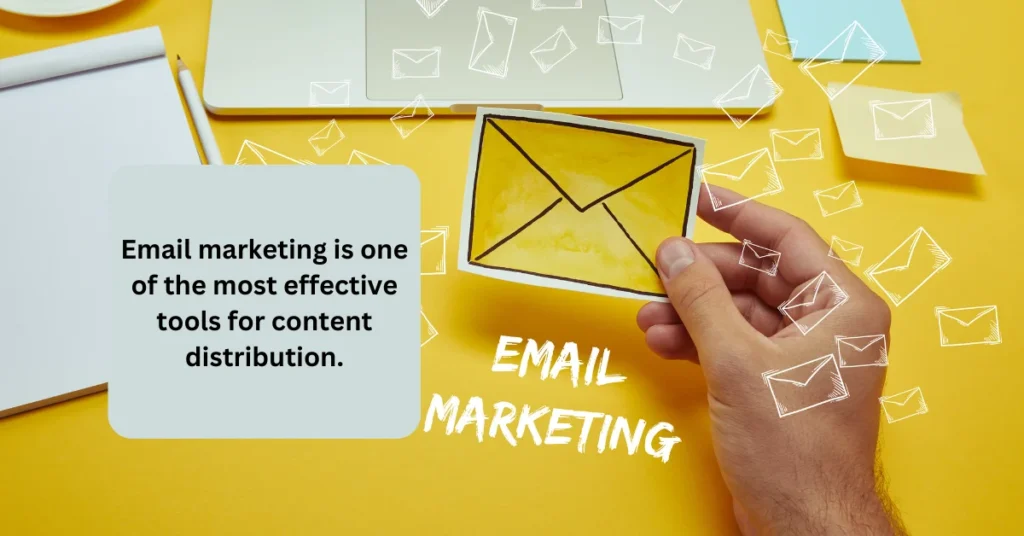
1. Build and Segment Your Email List
Before you can distribute content via email, you need a quality list of subscribers. Focus on building a list of engaged subscribers by offering valuable incentives like exclusive content, discounts, or webinars. Once you have a solid list, segment it based on various criteria to ensure your emails are relevant to the recipients:
- Behavioral Segmentation: Group subscribers based on actions they’ve taken, like downloading a guide or attending a webinar.
- Demographic Segmentation: Segment by age, location, job title, or industry to tailor your content to specific audiences.
- Engagement Segmentation: Create segments based on how often subscribers engage with your emails—this helps you target your most engaged audience with your best content.
2. Craft Compelling Email Campaigns
Your email campaigns should be engaging and encourage recipients to click through to your content. Focus on crafting emails that grab attention and offer value:
- Subject Lines: Write compelling, curiosity-driven subject lines that entice subscribers to open the email. Personalization, such as including the subscriber’s name or referencing their behavior, can also boost open rates.
- Content: Make sure your email content is concise and to the point. Highlight the value of the content you’re promoting and include a clear call to action (CTA) that directs readers to your content.
- Design: Use a clean and visually appealing design that aligns with your brand. Include eye-catching images or GIFs to draw attention, and make sure your emails are mobile-friendly.
3. Utilize Automation Tools for Consistent Outreach
Email automation tools, like Mailchimp or ConvertKit, allow you to set up automated email sequences that distribute your content at optimal times. This ensures consistent outreach without the manual effort:
- Welcome Series: Send new subscribers a series of welcome emails that introduce them to your brand and highlight your best content.
- Drip Campaigns: Create a series of emails that gradually introduce subscribers to different aspects of your content, encouraging them to engage over time.
- Behavior-Based Triggers: Set up automated emails triggered by specific actions, such as visiting a page on your website or downloading a lead magnet. This allows you to deliver targeted content at the right moment.
4. Test and Optimize Your Emails
To maximize the effectiveness of your email campaigns, you need to continuously test and optimize. Use A/B testing to compare different subject lines, email designs, or CTAs, and analyze the results to see what resonates best with your audience:
- Open Rates: Experiment with different subject lines and preview text to improve open rates.
- Click-Through Rates: Test different CTAs, links, and content layouts to see what encourages more clicks.
- Conversion Rates: Track which emails lead to conversions, whether that’s signing up for a webinar, downloading a resource, or making a purchase. Use this data to refine your approach and focus on the strategies that drive the most engagement.
By following these strategies, you can turn email marketing into a powerful distribution channel that drives traffic and engagement for your content. Next up, let’s explore how content syndication and guest posting can help you reach new audiences.
Section 5: Content Syndication and Guest Posting
While sharing content on your own platforms is essential, expanding your reach through content syndication and guest posting can significantly amplify your visibility. These strategies allow you to tap into existing audiences and establish your authority across different networks. Let’s explore how to effectively use these methods to distribute your content more widely.

1. Content Syndication: Expanding Your Reach
Content syndication involves republishing your content on third-party sites, which can introduce your work to a broader audience without creating new content from scratch. It’s a win-win: the hosting site gets fresh content, and you get more exposure.
- Identify Suitable Syndication Partners: Look for reputable sites in your industry that accept syndicated content. Popular options include Medium, LinkedIn Pulse, and niche-specific industry blogs.
- Understand Syndication Rules: Each site has its own rules regarding syndicated content. Some may require exclusive rights, while others allow previously published articles. Ensure you understand and comply with these guidelines to avoid any SEO penalties.
- Include a Clear Call to Action: When syndicating content, always include a CTA that directs readers back to your website. This could be a link to your original article or a relevant resource on your site.
2. Guest Posting: Building Authority and Backlinks
Guest posting is a powerful strategy for reaching new audiences and building credibility in your niche. By writing for other blogs or websites, you not only expand your reach but also enhance your SEO through high-quality backlinks.
- Find the Right Sites for Guest Posting: Look for websites that align with your brand and have an engaged audience. Sites that accept guest posts often have a “Write for Us” page or similar submission guidelines.
- Pitch Compelling Ideas: When reaching out to potential sites, craft a personalized pitch that highlights your expertise and the value you can provide to their audience. Focus on topics that are relevant to their readers and showcase your unique perspective.
- Write High-Quality, Original Content: Ensure your guest posts are well-researched, valuable, and tailored to the host site’s audience. This not only increases the chances of your post being accepted but also encourages readers to check out your site.
3. Benefits of Content Syndication and Guest Posting
Both content syndication and guest posting offer several benefits that make them worthwhile strategies for content distribution:
- Increased Exposure: Both methods allow you to tap into established audiences, boosting your visibility and reach.
- SEO Advantages: Guest posting on reputable sites provides valuable backlinks, which can improve your search engine rankings.
- Establishing Authority: Consistently contributing high-quality content to other platforms helps position you as an authority in your niche, building trust with both new and existing audiences.
4. Tips for Successful Syndication and Guest Posting
- Maintain Consistency: Regularly syndicating content or guest posting keeps your brand top of mind with new audiences.
- Engage with the Audience: After your content is published, engage with readers by responding to comments and participating in discussions. This builds relationships and encourages further engagement.
- Monitor Performance: Use tools like Google Analytics and social media metrics to track the performance of your syndicated and guest-posted content. Analyzing traffic and engagement data helps you understand what resonates with different audiences and refine your strategies.
By leveraging content syndication and guest posting, you can significantly broaden your content’s reach and establish a strong presence across multiple platforms. Next, let’s dive into the art of repurposing content to maximize its potential.
Shall we proceed to the section on repurposing content?
Section 6: Repurposing Content
Repurposing content is one of the most efficient ways to maximize your reach and engage different audience segments. By transforming a single piece of content into multiple formats, you can distribute it across various channels and appeal to diverse preferences. Let’s explore some creative ways to repurpose your content to get the most out of your hard work.
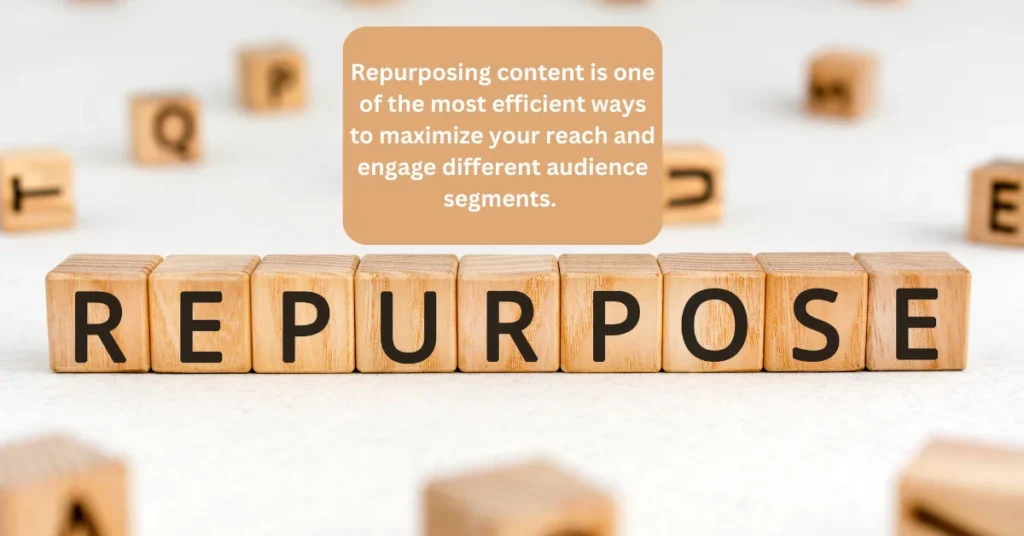
1. Transform Blog Posts into Videos or Infographics
Not everyone prefers reading long-form content. Some people are visual learners, while others enjoy video content. By turning a blog post into a video or infographic, you can cater to these different preferences and increase your content’s appeal.
- Create a Video Summary: Turn your blog posts into engaging videos by summarizing the key points and adding visuals or animations. Share these videos on YouTube, social media platforms, or embed them within the original blog post to increase time spent on your site.
- Design an Infographic: Visualizing data or processes through infographics can make complex information more digestible and shareable. Use tools like Canva or Piktochart to create eye-catching infographics and share them on Pinterest, LinkedIn, and other platforms.
2. Compile Articles into Ebooks or Guides
If you’ve written multiple articles on a related topic, consider compiling them into an ebook or comprehensive guide. This can serve as a valuable lead magnet to grow your email list or as a free resource to provide additional value to your audience.
- Create a Lead Magnet: Offer the ebook or guide as a free download in exchange for an email address. This helps you build your email list while providing valuable content to your audience.
- Publish on Multiple Platforms: Besides your website, publish the ebook on platforms like Amazon Kindle or Apple Books to reach a broader audience.
3. Turn Webinars and Podcasts into Written Content
Webinars and podcasts are excellent sources of content that can be repurposed into written formats. This not only extends the life of your content but also makes it accessible to those who prefer reading over listening or watching.
- Transcribe and Edit: Transcribe your webinars and podcasts and edit them into blog posts or articles. This allows you to reach readers who might have missed the original broadcast.
- Create Quotes and Soundbites: Extract key quotes or soundbites from your audio or video content and share them as social media posts. This helps drive traffic back to the full content and engages your audience in new ways.
4. Use Social Media Posts to Promote Existing Content
Your social media channels are not just for new content—they’re also great for resurfacing existing content. By regularly sharing your best-performing posts, videos, or guides, you can ensure they continue to reach new people.
- Schedule Evergreen Content: Use social media scheduling tools to regularly share evergreen content that remains relevant over time. This keeps your content in circulation and increases its chances of being seen by a wider audience.
- Create Snippets and Teasers: Turn key points from your content into short, engaging social media posts. Use quotes, questions, or interesting facts to intrigue your followers and encourage them to read or watch the full content.
5. Convert Data into Visual Content
If your content contains statistics, survey results, or other data, consider turning this information into visual content like charts or graphs. This not only makes the data more digestible but also increases the chances of it being shared on social media.
- Create Data Visualizations: Use tools like Google Data Studio or Tableau to create interactive charts and graphs that can be embedded in your blog posts or shared on social media.
- Design Slide Decks: Convert data-heavy content into slide decks for platforms like SlideShare or LinkedIn. This format is perfect for presenting complex information in a more engaging way.
By repurposing your content into different formats, you can reach new audiences and extend the life of your work. Next, let’s look at how to leverage influencers and partnerships to further expand your content distribution.
Section 7: Leveraging Influencers and Partnerships
Leveraging influencers and forming strategic partnerships are powerful tactics for expanding your content’s reach and tapping into new audiences. By collaborating with individuals and organizations that already have a loyal following, you can boost your visibility, build credibility, and drive more engagement with your content. Here’s how to make the most of these opportunities.
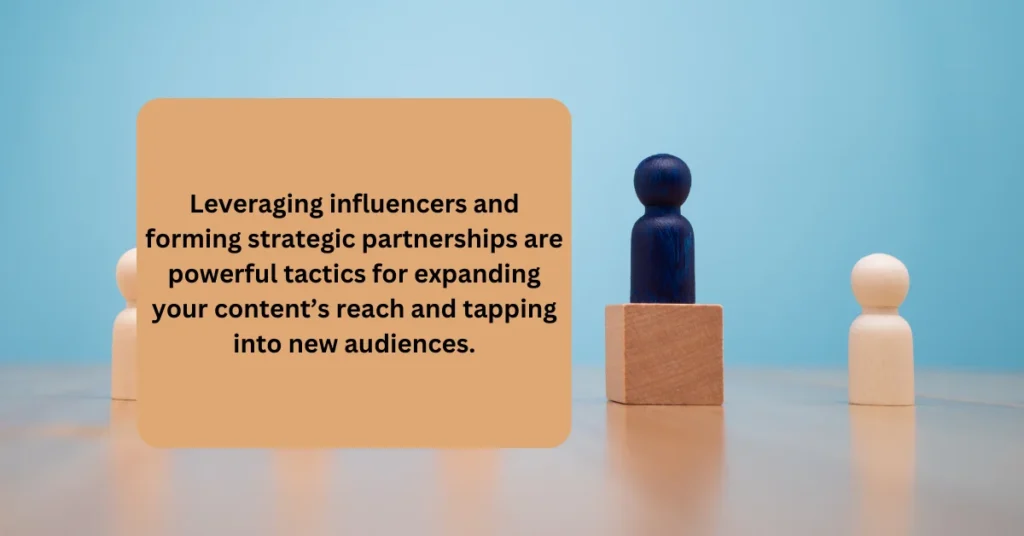
1. Identify the Right Influencers
Finding the right influencers to work with is crucial to your content distribution strategy. The goal is to collaborate with influencers whose audience aligns with your target market and who can authentically promote your content.
- Look for Relevance: Choose influencers who are relevant to your niche or industry. Their followers are more likely to be interested in your content if it aligns with the influencer’s usual topics and expertise.
- Check Engagement Rates: It’s not just about the number of followers; engagement is key. An influencer with a smaller, more engaged audience can be more valuable than one with a large but less active following.
- Assess Authenticity: Authenticity is critical in influencer marketing. Choose influencers who genuinely align with your brand values and can speak about your content or products with authenticity and enthusiasm.
2. Build Mutually Beneficial Relationships
Influencer partnerships should be a two-way street. Instead of a purely transactional approach, aim to build relationships that benefit both parties.
- Offer Value: Think about what you can offer in return for an influencer’s support. This could be exclusive content, co-creation opportunities, or even free access to your product or service.
- Co-Create Content: Collaborate with influencers on content creation. This could involve co-hosting a webinar, writing a guest blog post together, or creating a series of social media posts. Co-created content often feels more authentic and engaging to the influencer’s audience.
- Foster Long-Term Partnerships: Instead of one-off promotions, consider building long-term relationships with influencers. This can lead to ongoing support and more genuine endorsements over time.
3. Utilize Partnerships for Co-Branding and Content Sharing
Partnerships with other brands or organizations can also be a powerful way to distribute content and reach new audiences. These partnerships can take many forms, from co-branded content to cross-promotional campaigns.
- Co-Branded Content: Collaborate with a partner to create co-branded content that is shared across both audiences. This could be a joint research report, a collaborative video, or a co-hosted event. Co-branded content leverages the strengths and audiences of both partners, resulting in broader reach and increased credibility.
- Cross-Promotional Campaigns: Work with partners to promote each other’s content. This could involve sharing each other’s blog posts, featuring each other in newsletters, or mentioning each other in social media posts. Cross-promotional campaigns can be particularly effective if your partner’s audience closely aligns with your target market.
- Guest Features and Interviews: Invite partners to contribute guest posts to your blog or feature them in interviews, podcasts, or webinars. This not only adds value to your audience but also gives your partner an opportunity to share the content with their followers.
4. Measure the Impact of Influencer and Partnership Efforts
As with any content distribution strategy, it’s important to track and measure the effectiveness of your influencer and partnership efforts. This helps you understand what’s working and identify areas for improvement.
- Track Engagement Metrics: Monitor metrics such as likes, shares, comments, and click-through rates on influencer or partner-shared content. This will help you gauge the level of engagement and interest from their audience.
- Analyze Referral Traffic: Use tools like Google Analytics to track the amount of traffic driven to your site from influencer and partner channels. This will give you insight into how much visibility your content is gaining through these collaborations.
- Monitor Conversion Rates: If your goal is to drive specific actions (like sign-ups or sales), track the conversion rates from influencer and partner campaigns. This will help you determine the ROI of your efforts and refine your strategy accordingly.
By strategically leveraging influencers and partnerships, you can significantly expand your content’s reach, build credibility, and engage new audiences. Now, let’s wrap up with some key takeaways and a call to action.
Conclusion
Expanding the reach of your content is essential for any successful content marketing strategy. By using the right content distribution hacks, you can ensure your hard work doesn’t go unnoticed and reaches the audiences who matter most. From optimizing your social media strategy and leveraging the power of email marketing, to expanding your reach through content syndication, guest posting, and repurposing content, there are countless ways to get your content seen everywhere.
Partnering with influencers and other brands can amplify your reach even further, allowing you to tap into new audiences and build credibility through authentic endorsements. Remember, the key to effective content distribution is not just about pushing content out there, but about strategically sharing it where it will have the most impact.Ready to take your content distribution to the next level? Start implementing these strategies today and watch your content visibility soar. Don’t forget to subscribe to our newsletter for more valuable content marketing tips and tricks, and feel free to share your own favorite content distribution hacks in the comments below. We’d love to hear from you!










